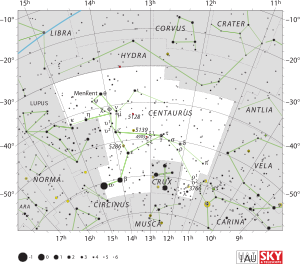HD 124448
| HD 124448 HD 124448[1] | ||
|---|---|---|
| 仮符号・別名 | Popper's star[2] | |
| 星座 | ケンタウルス座 | |
| 見かけの等級 (mv) | 9.98[1] 9.94-10.03(変光)[3] | |
| 変光星型 | PVTEL[3] (ぼうえんきょう座PV型変光星) | |
| 分類 | 極端ヘリウム星[4] | |
| 位置 元期:J2000.0 | ||
| 赤経 (RA, α) | 14h 14m 58.6292609018s[5] | |
| 赤緯 (Dec, δ) | −46° 17′ 19.294106424″[5] | |
| 赤方偏移 | -0.000223[5] | |
| 視線速度 (Rv) | -67.00 km/s[5] | |
| 固有運動 (μ) | 赤経: -6.544 ミリ秒/年[5] 赤緯: -0.049 ミリ秒/年[5] | |
| 年周視差 (π) | 0.6240 ± 0.0312ミリ秒[5] (誤差5%) | |
| 距離 | 5200 ± 300 光年[注 1] (1600 ± 80 パーセク[注 1]) | |
| 絶対等級 (MV) | -1.0[注 2] | |
HD 124448の位置
| ||
| 物理的性質 | ||
| スペクトル分類 | B2[1] | |
| 有効温度 (Teff) | 16800 K[6] | |
| 金属量[Fe/H] | 1.01[6] | |
| 他のカタログでの名称 | ||
| V821 Cen[1], 2MASS J14145863-4617192[1], HIP 69619[1], Gaia EDR3 6095832381546853888[5] | ||
| ■Template (■ノート ■解説) ■Project | ||
HD 124448 (V821 Centauri) は、太陽系から見てケンタウルス座の方向約5,200光年の距離にある10等星の恒星。スペクトル中に水素の吸収線スペクトルがほとんど見られず、強いヘリウムの吸収線が見られる「極端ヘリウム星」に分類され、このタイプの恒星としては史上初めて発見されたものである。変光星としてはぼうえんきょう座PV型変光星に分類される脈動変光星である[3]。
1942年、アメリカ テキサス州オースティンにあるマクドナルド天文台でHD 124448を分光観測したアメリカの天体物理学者ダニエル・M・ポッパーは、この星のスペクトルの奇妙な特徴に気付いた[7][8]。スペクトル中には水素の輝線も吸収線も存在せず、鋭く強いHe Iの吸収線と、O IIとC IIの吸収線が存在していた[7][8]。1952年によく似たスペクトルを持つぼうえんきょう座PV星 (HD 168476) が発見されると、HD 124448は発見者の名前を取って Popper's star とも呼ばれるようになった[2]。
HD 124448のような極端ヘリウム星は、単独の恒星として進化したのではなく、既に恒星の段階を終えた炭素-酸素白色矮星とヘリウム白色矮星が合体し、再びヘリウム核融合が始まったものと考えられている[4][9]。
脚注[編集]
注釈[編集]
出典[編集]
- ^ a b c d e f “V* V821 Cen -- Pulsating variable Star”. SIMBAD Astronomical Database. CDS. 2021年12月29日閲覧。
- ^ a b “H.D. 168476 and 124448 - two similar stars”. The Observatory 72: 248-249. (1952). Bibcode: 1952Obs....72..248T. ISSN 0029-7704.
- ^ a b c Samus’, N. N.; Kazarovets, E. V.; Durlevich, O. V.; Kireeva, N. N.; Pastukhova, E. N. (2017). “General catalogue of variable stars: Version GCVS 5.1”. Astronomy Reports 61 (1): 80-88. Bibcode: 2017ARep...61...80S. doi:10.1134/S1063772917010085. ISSN 1063-7729.
- ^ a b Pandey, Gajendra et al. (2006). “An Analysis of Ultraviolet Spectra of Extreme Helium Stars and New Clues to Their Origins”. The Astrophysical Journal 638 (1): 454-471. arXiv:astro-ph/0510161. Bibcode: 2006ApJ...638..454P. doi:10.1086/498674. ISSN 0004-637X.
- ^ a b c d e f g h Gaia Collaboration. “Gaia data early release 3 (Gaia EDR3)”. VizieR On-line Data Catalog: I/350. Bibcode: 2020yCat.1350....0G.
- ^ a b Hill, P. W. (1965-02-01). “The Spectra of Helium Stars, II: An Abundance Analysis of Three Helium Stars”. Monthly Notices of the Royal Astronomical Society (Oxford University Press (OUP)) 129 (2): 137–158. Bibcode: 1965MNRAS.129..137H. doi:10.1093/mnras/129.2.137. ISSN 0035-8711.
- ^ a b Popper, Daniel M. (1942). “A Peculiar B-Type Spectrum”. Publications of the Astronomical Society of the Pacific (IOP Publishing) 54: 160. Bibcode: 1942PASP...54..160P. doi:10.1086/125431. ISSN 0004-6280.
- ^ a b “A Peculiar B-Type Spectrum”. Publications of the Astronomical Society of the Pacific (IOP Publishing) 54: 161. (1942). Bibcode: 1942PASP...54..161.. doi:10.1086/125433. ISSN 0004-6280.
- ^ Saio, Hideyuki; Jeffery, C. Simon (2002). “Merged binary white dwarf evolution: rapidly accreting carbon-oxygen white dwarfs and the progeny of extreme helium stars”. Monthly Notices of the Royal Astronomical Society 333 (1): 121-132. Bibcode: 2002MNRAS.333..121S. doi:10.1046/j.1365-8711.2002.05384.x. ISSN 0035-8711.

